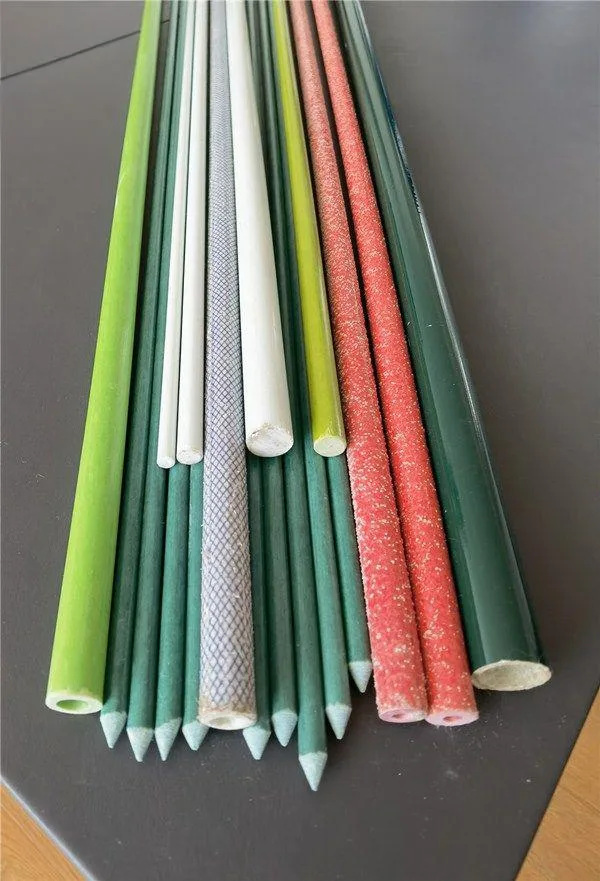Introduction
Choosing the right material for construction or DIY projects significantly influences the project’s success and durability. One decision that frequently arises is whether to use round fiberglass rods or traditional steel rods. Fiberglass has become increasingly popular due to its unique properties, but does it truly surpass steel in performance and reliability? In this article, we’ll closely examine the advantages and disadvantages of round fiberglass rods compared to steel, providing clear insights to help you make an informed decision for your next project.

round fiberglass rods
Pros of Using Round Fiberglass Rods
Lightweight Yet Strong
Fiberglass rods are renowned for their strength-to-weight ratio, often superior to traditional steel. They are significantly lighter, making them easier to transport, handle, and install, particularly for projects at height or in difficult-to-access areas.
Fiberglass rods typically weigh approximately 70% less than steel of equivalent strength, reducing overall structural weight.
Their lightweight nature significantly reduces labor costs and installation time.
Corrosion Resistance
Unlike steel, round fiberglass rods don’t rust or corrode when exposed to moisture, chemicals, or harsh environments.
Ideal for marine environments, wastewater treatment plants, or chemically aggressive industrial settings.
Long-lasting, saving maintenance and replacement costs in the long run.
Non-Conductive and Safe
Fiberglass rods provide excellent electrical insulation, making them ideal for electrical applications or situations requiring non-conductive materials.
Widely used in power distribution, telecommunications, and electrical fencing.
Enhances safety for workers by eliminating the risk of electrical conductivity.
Thermal Stability and Low Expansion
Fiberglass maintains its structural integrity under temperature fluctuations better than steel.
Fiberglass rods experience minimal thermal expansion and contraction, preventing structural stress.
Particularly valuable in outdoor applications subject to extreme temperature variations.
Versatility and Customizability
Round fiberglass rods are easily manufactured in various diameters, lengths, and colors to suit specific project requirements.
Can be tailored to fit precise specifications for custom jobs.
Their versatility extends to decorative, structural, and industrial applications alike.
Cons of Using Round Fiberglass Rods
Lower Ultimate Tensile Strength
Despite excellent strength-to-weight ratios, fiberglass rods generally have lower tensile strength compared to high-grade steel.
In projects requiring extremely high tensile loads, steel often remains the preferred option.
Fiberglass rods may not be suitable for structural applications demanding the absolute highest strength.
Cost Considerations
The initial cost of fiberglass rods can be higher than traditional steel rods.
Higher upfront investment might discourage budget-sensitive projects.
However, long-term savings in maintenance and durability often offset this initial price premium.
Susceptibility to Impact Damage
While fiberglass is strong and flexible, it can be susceptible to impact damage under certain conditions.
Sharp impacts can cause surface fractures or weakening of the internal structure.
Steel rods may withstand heavy impacts better in scenarios involving repeated mechanical stress or shock.
Limited Bending Flexibility
Fiberglass rods typically offer less flexibility in bending compared to steel.
Excessive bending can cause permanent structural damage or reduced strength.
Applications demanding significant flexibility might find steel rods more practical and effective.
Comparison: When to Choose Round Fiberglass Rods vs. Steel
When to Opt for Fiberglass Rods
Electrical and telecommunications projects requiring non-conductivity.
Marine or chemical environments where corrosion resistance is critical.
Lightweight construction or situations where ease of installation is crucial.
Applications involving exposure to extreme temperature variations.
When to Choose Steel Rods
High-tensile strength applications (e.g., heavy load-bearing structures).
Projects with very tight budget constraints where initial investment must be minimized.
Situations with frequent heavy impacts or dynamic mechanical loads.
Scenarios requiring significant flexibility or repetitive bending.
Expert Opinion
According to construction material experts, fiberglass rods are increasingly favored for their long-term cost benefits and environmental resistance. However, engineer Mark D. Thompson states, “While fiberglass rods excel in specialty applications, steel remains unmatched in scenarios demanding very high tensile loads and extreme mechanical durability.” Understanding the project’s specific needs is thus essential in making the optimal material choice.
Conclusion
The choice between round fiberglass rods and steel ultimately depends on your project’s particular requirements and priorities. Fiberglass offers significant advantages in corrosion resistance, weight reduction, and electrical insulation, making it ideal for many modern applications. However, steel’s superior tensile strength, lower upfront cost, and impact resilience still make it a preferred choice for specific heavy-duty applications.
Carefully evaluating your project’s scope, environment, and long-term requirements will help ensure that you select the right material to maximize performance, safety, and value.
Call to Action
Have you had experience using round fiberglass rods in your projects? Share your thoughts and experiences in the comments below, and don’t forget to subscribe for more expert insights into construction materials and techniques!




























